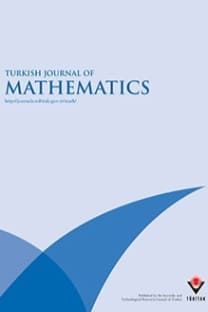A class of uniquely (strongly) clean rings
Clean ring, strongly clean ring, uniquely clean ring, strongly J-clean ring
A class of uniquely (strongly) clean rings
___
- Anderson, F.W., Fuller, K.R: Rings and Categories of Modules. New York. Springer-Verlag 1974.
- Baccella, G.: Exchange property and the natural preorder between simple modules over semi-Artinian rings. J. Algebra 253, 133–166 (2002).
- Camillo, V.P., Khurana, D., Lam, T.Y., Nicholson, W.K., Zhou, Y.: Continuous modules are clean. J. Algebra 304, 94–111 (2006).
- Camillo, V.P., Yu, H.P.: Exchange rings, units and idempotents. Comm. Algebra 22, 4737–4749 (1994).
- Camillo, V.P., Yu, H.P.: Stable range one for rings with many idempotents. Trans. Amer. Math. Soc. 347, 3141–3147 (1995).
- Chen, H.: On strongly J-clean rings. Comm. Algebra 38, 3790–3804 (2010).
- Chen, J., Wang, Z., Zhou, Y.: Rings in which elements are uniquely the sum of an idempotent and a unit that commute. J. Pure Appl. Algebra 213, 215–223 (2009).
- Haghany, A., Varadarajan, K.: Study of formal triangular matrix rings. Comm. Algebra 27, 5507–5525 (1999). Han, J., Nicholson, W.K.: Extensions of clean rings. Comm. Algebra 29, 2589–2595 (2001).
- Handelman, D.: Perspectivity and cancellation in regular rings. J. Algebra 48, 1–16 (1977).
- Khurana, D., Lam, T.Y.: Rings with internal cancellation. J. Algebra 284, 203–235 (2005).
- Lee, T.K., Yi, Z., Zhou, Y.: An example of Bergman’s and the extension problem for clean rings. Comm. Algebra 36, 1413–1418 (2008).
- Lee, T.K., Zhou, Y.: A class of exchange rings. Glasgow Math. J. 50, 509–522 (2008).
- Nicholson, W.K.: Lifting idempotents and exchange rings. Trans. Amer. Math. Soc. 229, 269–278 (1977).
- Nicholson, W. K., Varadarajan, K., Zhou, Y.: Clean endomorphism rings. Arch. Math. 83, 340–343 (2004).
- Nicholson, W.K., Yousif, M.F.: Weakly continuous and C2 conditions. Comm. Algebra 29, 2429–2446 (2001). Nicholson, W.K., Zhou, Y.: Rings in which elements are uniquely the sum of an idempotent and a unit. Glasgow Math. J. 46, 227–236 (2004).
- ¨ Ozcan, A.C ¸ ., Aydo˘ gdu, P.: A generalization of semiregular and almost principally injective rings. Algebra Coll. 17, 905–916 (2010).
- Yousif, M.F., Zhou, Y.: Semiregular, semiperfect and perfect rings relative to an ideal. Rocky Mountain J. Math. 32, 1651–1671 (2002).
- Yu, H.P.: On quasi-duo rings. Glasgow Math. J. 37, 21–31 (1995).
- Zhou, Y.: Generalizations of perfect, semiperfect and semiregular rings. Algebra Colloq. 7, 305–318 (2000).
- ISSN: 1300-0098
- Yayın Aralığı: Yılda 6 Sayı
- Yayıncı: TÜBİTAK
On Finsler metrics with vanishing S-curvature
Akbar TAYABI, Hassan SADEGHI, Esmaeil PEYGHAN
On Kakutani Krein and Maeda Ogasawara spaces
On Kakutani--Krein and Maeda--Ogasawara spaces
On the structure of some modules over generalized soluble groups
Leonid Andreevich KURDACHENKO, Igor Yakov SUBBOTIN, Vasiliy Anatolievich CHUPORDYA
On Betti series of the universal modules of second order derivations of \frac{k[x1,x2,...,xs]}{(f)}
Ali ERDOĞAN, Halise Melis Tekin AKÇİN
A class of uniquely (strongly) clean rings
Ayşe Ciğdem OZCAN, Orhan GURGUN
On Betti series of the universal modules of second order derivations of k[x1,x2,...,xs] (f)
Ali ERDOGAN, Halise Melis AKCIN TEKIN
Ibrahim TEKIN, Mansur ISMAILOV ISGENDEROGLU
Geometry of almost Cliffordian manifolds: classes of subordinated connections
